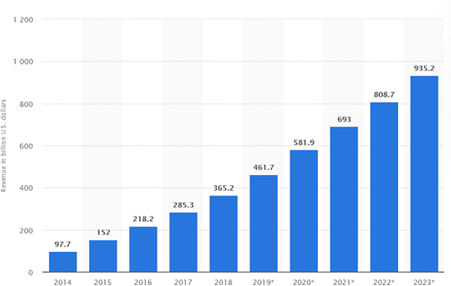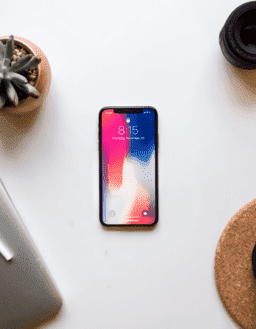7 Mobile App Development Trends To Look In 2020-2021

Are you aware that more than 7 billion people are on the planet, and nearly 4.7 billion use mobile devices?
Statistics also show that 90% of mobile time is spent on applications. According to Statista, the mobile app development revenue is expected to soar to $693 billion by 2021. It is an increase of $ 112 billion compared to 2020.
Do you know what caused this achievement? Were there any mobile development trends that pushed the envelope? Let’s check out.
1. MACHINE LEARNING IS ABOUT MAKING AI EVEN SMARTER
Artificial intelligence and machine learning will remain high priorities in app development. Both businesses and consumers are embracing AI tools to make their work and lives more manageable.
So what will be new on the machine learning front?
Well, evolution will likely keep up to take precedence over revolution. We’re looking forward to seeing more AI upgrades for things like search suggestions, spell checks, and product recommendations. The final goal is to allow users to perform daily tasks smoothly by eliminating tedious and time-consuming tasks. Deep learning will also influence AI by inspecting users’ daily routines and activities. The system will study a user’s needs based on the data it collects over time to increase the user experience. Siri, Alexa, and Google Assistant are the best examples of programs that are capable of machine learning. They’re optimized for speech and face recognition and can order takeout, book appointments, and add events to Google Calendar.
Catagories
Categories
Have Any Question?
Do not hesitage to give us a call. We are an expert team and we are happy to talk to you.

2. SAY GOODBYE TO SMARTPHONES AND HELLO TO WEARABLES
3. FASTER & MORE POWERFUL APPS WITH 5G
Once every few years, we see massive leaps in Internet connection speeds. We’ve come a long way from dial-up and are presently spoiled with download rates as high as 1,000 Mbps. Now, 5G networks are being rapidly adopted across the globe, enabling mobile devices to have even higher connection rates. It is reportedly 20 times faster than 4G LTE, which may reach a maximum of 1 GB per second.
It indicates it improved online connectivity among devices. However, 5G will not only improve internet communications; it will also enable more effective drone control.
Giant companies like Manna and Valqari are already leveraging the advantages of this by offering drone deliveries as a service. However, restaurants mostly use it to deliver food and packages to their customers.
5G boasts more security than 3G and 4G networks, a crucial worry in the era of massive data. But, considering its speed and reliability, it’ll make devices powerful enough for resource-expensive VR and AR app games.
4. MORE IMPRESSIVE AR / VR
The progress of augmented reality has been pretty remarkable. Thanks to the enhancements in ARKit (iOS) and ARCore (Android), it is now possible to place augmented reality (AR) objects behind and in front of real-world objects in real time. It is useful when using, for instance, an interior design app: you can now see how furniture will fit in your room by using the camera on your smartphone and choosing appropriately.
It allows brands like Ikea to build interior design apps for customers. Bosch also has a similar app, allowing you to develop simplified sketches of floor plans quickly. In addition, the technology behind VR/AR has advanced and offers better optimization and stability for these apps. So it’s likely to bring up more entrepreneurs to create more virtual reality apps.
5. IOT WILL CONTINUE BUILDING SMART HOMES
People are not merely utilizing smart devices; they are living with them. Google Home and Apple Home enable users to transform their houses into smart homes.
It is achievable by using devices compatible with Google and Apple. With this, you can find all sorts of appliances now connected to the Internet, including air purifiers, pet feeders, lamps, and blinds. And Google and Apple aren’t done yet; they’re devoted to supporting more devices soon.
6. APPS WILL OPERATE ACROSS MULTIPLE PLATFORMS
What functions on Android may not always work on iOS. So is the reason why there are two separate app markets.
However, this doesn’t mean that developing an application that works on multiple devices is impossible. And we’re not just speaking of smartphones and tablets, but desktops. It is what we’re witnessing with JetBrains’ Kotlin multi-platform projects. You can use a single language to build applications for all three platforms. In addition, developers can do coding for every part of the system: backend, frontend, mobile apps, and desktop apps. React Native enables developers to create mobile applications for iOS and Android using a unified codebase. It is written in JavaScript but is rendered with native code. Flutter is another platform that allows developers to create mobile, web, and desktop applications using a single Dart-based codebase. Although it’s recent, it’s gaining a lot of traction.
The support of large firms like Google, JetBrains, and Facebook brightens the future of these cross-platform solutions. As a result of their commitment to ongoing development, we may anticipate significant progress in the following years.
7. THE ROLE OF HARDWARE IN MOBILE APP DEVELOPMENT IS CERTAIN.
These devices have improved speed, storage, and general functionality over time-based on the hardware in smartphones, wearables, and tablets. So do you know what effect hardware will have on mobile app trends? The shape of the devices will stay the same. However, its internal hardware will include enhanced parameters, such as greater RAM, more storage capacity, and quicker processors. Additionally, this will improve battery life and photo capabilities. As a result, users can produce more spectacular photos and movies between charges. As hardware upgrades, the possibilities for bigger, better, faster, and more powerful mobile apps will also become more significant.
KEEPING UP WITH MOBILE APP DEVELOPMENT TRENDS
WHAT MAKES MAXSOURCE ONE OF THE BEST MOBILE APPLICATION DEVELOPMENT COMPANIES IN THE USA?
Maxsource always stays updated with the progression of technology. Our team of skilled professionals is rich with technical expertise in varied technologies used in the industry across various domains. We work with simplified architecture based on standard components and services and build up applications from medium to highly complex to meet demand across multiple systems and ensure optimization. As a traditional software development process, we leverage the full advantage of capabilities, features, and tools for developing complex business applications. So if you want to create feature-rich mobile apps that take advantage of the newest trends, look no further. We are here for you. Visit: www.maxsourceworld.com.
















































